The ASRock X399 Professional Gaming Motherboard Review: 10G For All
by E. Fylladitakis on July 5, 2018 8:00 AM EST- Posted in
- Motherboards
- AMD
- Gigabyte
- ASRock
- Asus
- 10GBase-T
- ThreadRipper
- X399
Visual Inspection
Even though the ASRock X399 Professional Gaming is targeted to gamers, its design is not as extravagant as we expected it to be. Perhaps the only thing that stands out in terms of aesthetics are the sharp, futuristic heatsinks. The two heatsinks that cool the processor's VRM circuitry are connected with a heatpipe but there is no extra fan for active cooling. The designer used black color for the PCB and plastics, and preserved the natural color of metal for all metallic parts, creating a nice visual antithesis. RGB lighting is present but limited to the area surrounding the chipset's heatsink, with headers for adding external 12V RGB LED strips. Note that this motherboard does not support RGBW or digital RGBW/UV LED products.
ASRock advertises the X399 Professional Gaming as having an 11-phase design. Actually, the motherboard has an 8-phase VRM circuit that uses the International Rectifier (Infineon) IR35201 digital controller, plus another 3-phase VRM circuit for the SoC. There is nothing irregular here, with ASRock going with a by-the-book approach and installing IR3555 MOSFET drivers (rated at 60A each) and 60A inductors. The IR35201 is a digital controller by International Rectifier that evenly distributes the load across the eight phases at all times, greatly improving the longevity of the components. The power circuitry is more powerful than that of less costly motherboards, potentially allowing for higher overclocks and, perhaps, compatibility with future versions of the Ryzen Threadripper processor.
The audio circuitry is interesting. It sports a Realtek ALC 1220 chipset as its core and an additional Texas Instruments NE5532 amplifier for the headphones. The main chipset is rated for a maximum rated sound-to-noise ratio (SNR) of 120dB. To help achieve that performance figure, ASRock physically isolated the right/left channel audio channels on individual layers and is using Nichicon audio-specific capacitors. The sound circuitry supports the Creative Sound Blaster Cinema 3 Software.
The layout of the ASRock X399 Professional Gaming generally is good but there are some questionable design choices. As expected, most of the internal headers have been placed across the bottom edge of the motherboard. From left to right, there are two front panel audio headers, one standard and one vertical, a COM port header, a header for a 12V RGB strip, a standard 4-pin fan header, a TPM header, an extra power LED/system speaker header, two headers for USB 2.0 ports, a small CMOS reset switch, a debugging LCD, one USB 3.1 Gen 1 header, two gold-colored power/reset buttons, and the system switch/LED header. There is a second USB 3.1 Gen 1 header to the right of the motherboard, right next to the ATX 24-pin power connector.
Oddly, ASRock installed a 6-pin PCIe connector on the lower right edge of the motherboard that serves as an additional power source. The use of an extra power connector is not strange on AMD X399 motherboards that support quad SLI but the choice of this particular connector is, as it would force users who want to use four graphics cards to use an adaptor on Molex connectors because mosts PSU will top out at eight PCIe connectors.
Eight SATA connectors can be seen to the lower right side of the motherboard, all facing rightwards. A U.2 PCIe ×4 connector is present right above the SATA connectors. The ASRock X399 Professional Gaming also has three M.2 PCIe ×4 slots and all three support drives up to 80 mm long - there are no slots that support 110 mm long drives on the ASRock X399 Professional Gaming. One of the slots supports the currently rare ultra-short 32 mm M.2 devices. Unlike with other manufacturers, none of the M.2 slots has any heatsinks. No PCI lanes are being shared between the three M.2 slots, meaning that they can all run at ×4 simultaneously. However, the U.2 slot shares its lanes with the third M.2 slot and will disable this slot entirely should a U.2 device is installed.
Another odd design choice, as shown below, is the placement of the CPU's EPS power connectors. The 8-pin and 4 pin 12V CPU connectors are placed at the top right and top left side of the motherboard respectively. ASRock advertises this as an advantage, as it creates a wider trace for the CPU's VRMs. The concept is technically sound from an engineering point of view but it also could create compatibility problems because several PSUs have both CPU 12V connectors on a single cable, meaning that an extension would be necessary to reach the second connector on the motherboard. A thicker copper layer would certainly produce better results but, since ASRock is already using a 2oz copper PCB, a thicker copper layer would greatly increase the motherboard's manufacturing cost. Another odd design choice is the placement of two fan headers between the CPU's socket and the first PCIe slot, where they will be practically inaccessible after a CPU heatsink and a graphics card are installed.
USB connectors dominate the rear panel of the ASRock X399 Professional Gaming. Starting from the top of the motherboard, we can see a small BIOS "flashback" switch, two USB 3.1 Gen 1 connectors and a PS/2 combo connector, two wireless antenna connectors, two USB 3.1 Gen 1 connectors, five gold-plated 3.5 mm audio jacks and one optical SPDIF connector, two USB 3.1 Gen 1 connectors and the red Aquantia 10Gbps NIC, another two USB 3.1 Gen 1 connectors and the first I211-AT NIC, and, finally, the two USB 3.1 Gen 2 10 Gbps connectors (one Type-A and one Type-C) and the second I211-AT NIC.


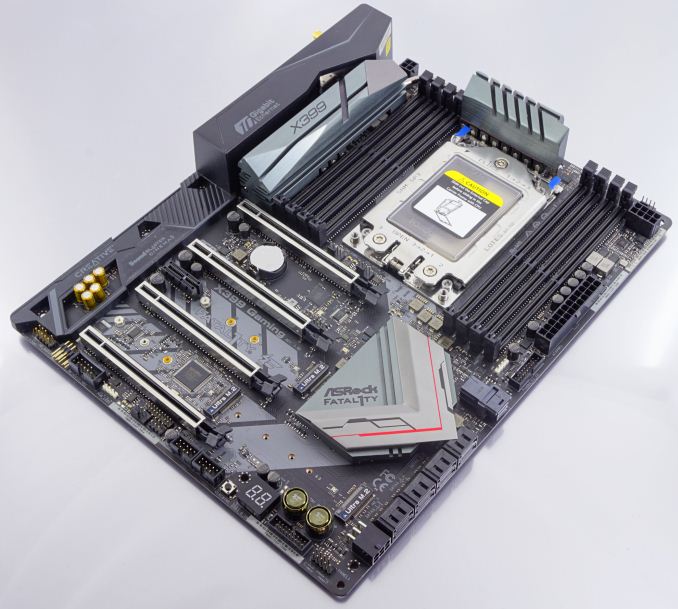
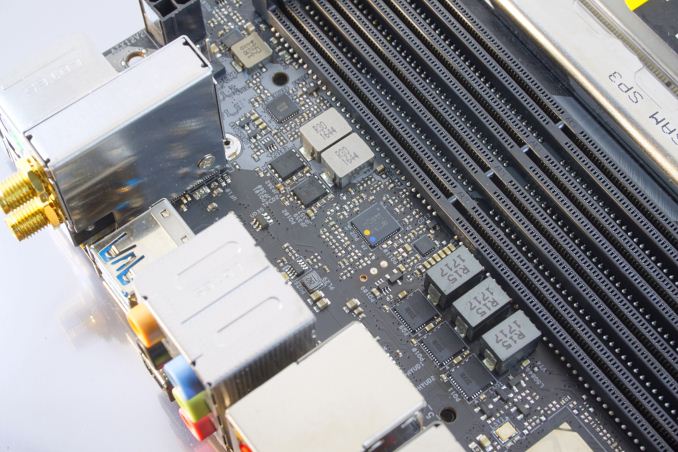
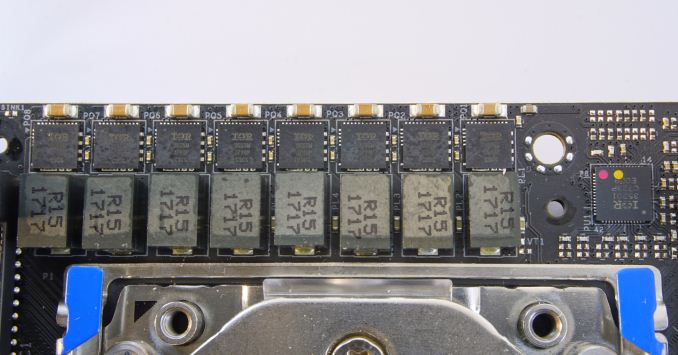
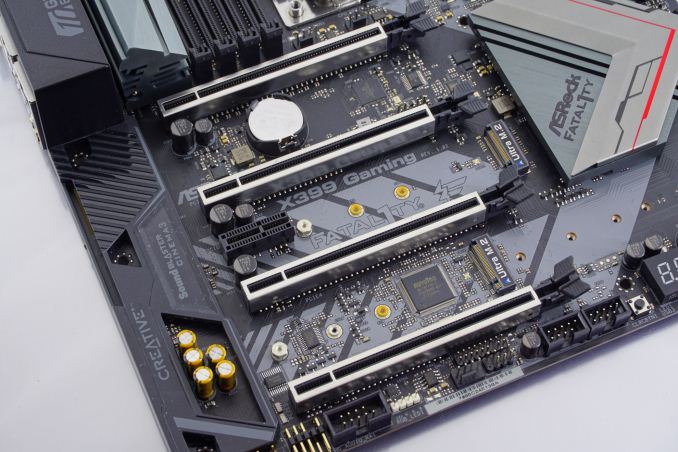

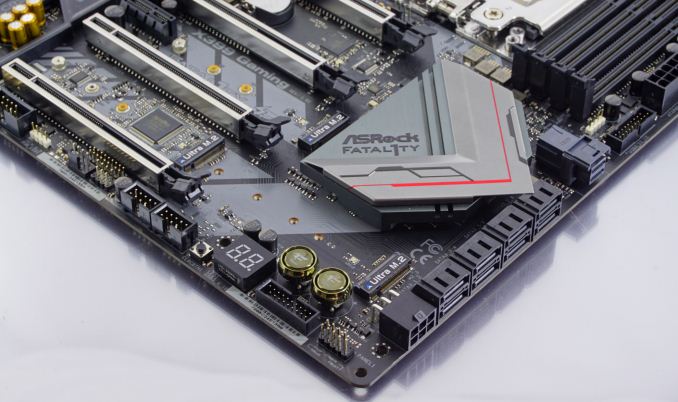
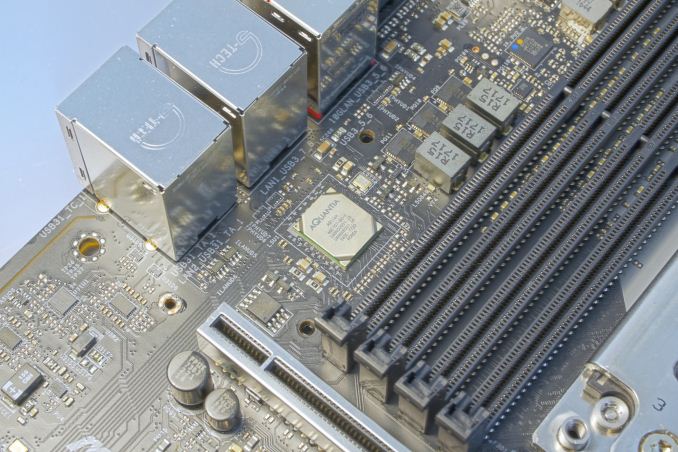
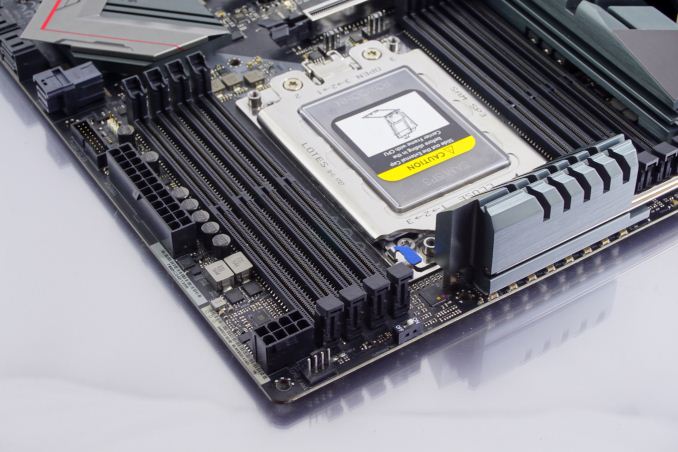
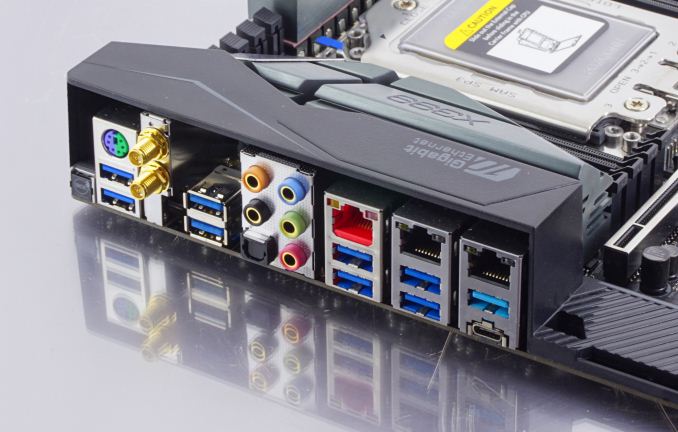








43 Comments
View All Comments
tmediaphotography - Thursday, July 5, 2018 - link
From pg#1 "but there is no mention of circuitry/channel isolation."From pg#2 "To help achieve that performance figure, ASRock physically isolated the right/left channel audio channels on individual layers"
May want to fix this up.
Ryan Smith - Friday, July 6, 2018 - link
Right you are. Thanks!PaoDeTech - Thursday, July 5, 2018 - link
My guess is that a 10GbE port adds ~$30. I'd be very interested to know what prosumer use cases would benefit from 10GbE. I would be great if Anandtech did a test with, e.g., some kind of 4K video rendering farm that makes use of 10GbE enabled PCs / switches / NAS /... (I know: easy to ask, hard to do).oRAirwolf - Friday, July 6, 2018 - link
I have the z370 gaming professional version of this board that also includes 10gbe. I have a direct connection between my desktop and my file server. It's really nice being able to transfer backups and video files between the two computers at much higher speeds. I usually read and write at about 600 megabytes per second, with it being limited by the 8x8tb wd reds. I think it is one of those things where once you have it, it sucks not having it. Like nobody needs internet faster than 10 megabits per second but it sure is nice having gigabit internet.Gunbuster - Thursday, July 5, 2018 - link
Opens the ASRock support page: 2017 2017 2017, all software/drivers/prod BIOS from 2017.rtho782 - Thursday, July 5, 2018 - link
>A gaming-specific NIC such as a Killer E2500 would make the motherboard more appealing to gamers, whereas the more expensive Aquantia 10G chip primarily serves other users.That's funny, I consider myself a gamer, and yet I won't touch any board with a "Killer" NIC, I'll avoid it in favour of an Intel NIC at all costs.
PeachNCream - Thursday, July 5, 2018 - link
Anandtech has weird love butter for Killer NICs and no substantiation for it via benchmarks. It's been that way since sometime in 2016 and a lot of us don't get why there appears to be some sort of institutionalized need to champion the dumpster fire over at Rivet Networks.rhysiam - Thursday, July 5, 2018 - link
I agree... why does AT keep obsessing about Killer NICs? I pay more if necessary to avoid them for an Intel NIC. Although it is possible to create a scenario where the traffic prioritisation software on the LAN connection can help, it's so rarely impactful in the real-world. The most common real world causes of lag, like family members smashing your internet connection, aren't addressed at all by some local software prioritisation.oRAirwolf - Friday, July 6, 2018 - link
Agreed. Any enterprise-grade router will enhance your latency way more than some nonsense software. With vendors like Ubiquiti and Mikrotik, as well as software routers like pfSense and Sophos, there's really no good reason to spend the money on a consumer-grade router. You can have an enterprise-grade setup with a high quality access point for the same price as some of these crab-looking routers they sell at Best Buy.phoenix_rizzen - Wednesday, July 11, 2018 - link
Aren't the latest Killer NICs just Intel NICs with custom Killer drivers? IOW, wouldn't it be possible to just install the Intel drivers for it instead of the Killer drivers?